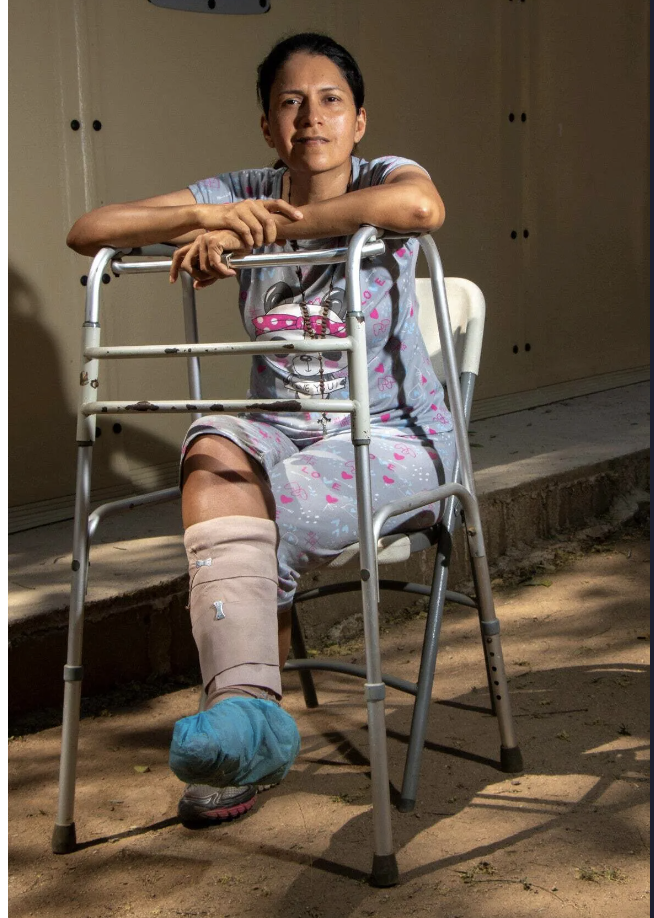World Refugee Day: Through the Darien Gap on a Broken Leg

Marisol Perez, a 51-year-old migrant currently in Honduras, has made countless decisions since she left her Venezuelan home five years ago. None of them have been easy.
Today she sits in a folding chair outside a tent in a Honduran refugee shelter, waiting for her badly fractured leg to heal. It’s a leg that was shattered because of a lose-lose choice she was forced to make as she traveled through Panama’s Darien Gap.
A life never far from violence
Marisol is dressed in grey shorts and a matching T-shirt emblazoned with a cartoon panda that peeks out from behind the rosary she wears. As Marisol traveled from her home in Venezuela through Colombia, Panama, Costa Rica, and Nicaragua to Honduras, she was never far from violence. Migrants are routinely robbed, murdered, and sexually assaulted as they travel though a landscape so difficult, many people routinely dump essential supplies just to get through.
More than four years ago, Marisol, her adult daughter, and her granddaughter left Venezuela’s decimated economy and dangerous streets for a safer life in Colombia, where they settled. The years went by and conditions in Colombia also began to deteriorate. Roughly a year ago, Marisol decided to head north again to scout a better life for the family. Because she felt her granddaughter, Viviana, was too young to endure the infamously rough terrain of the Darien Gap, Marisol began the second phase of her trip alone, leaving her family in Colombia.
Marisol's leg was fractured when traversing Panama's notorious Darien Gap.
The most trecherous pathway
Eventually Marisol began to travel with a young man she met along the way. Informal arrangements like this one are a common way for migrants to band together for safety. Soon enough the duo entered the Darien Gap, a 60-mile-long land bridge that runs through Panama, connecting North and South America.
According to Human Rights Watch, “the Darien Gap is one of the most treacherous migration pathways in the world, made even more so by the dearth of government and humanitarian assistance in the jungle.”
It was here that Marisol faced another choice.
One evening inside the Darien Gap, her traveling companion wanted to push on past sunset. Marisol was afraid that she would fall in the dark and injure herself, but she was equally afraid to stay behind alone. They kept walking. Marisol slipped and fell, injuring her leg. At the time, she did not realize the extent of the damage.
She continued on, fueled by adrenaline that soon receded.
“When we got up, my foot was extremely swollen, and everything was very dark purple,” she said. “I continued my journey, so I walked for eight hours fractured because my fear was to stay there, in that jungle. My fear was that I would not be able to advance any further.”
“I didn’t know what would happen to me if I stayed there. There came a time when I couldn’t hold my foot any further, and I couldn’t stand the pain anymore, and I lay down on a stone.”
Her traveling companion and other migrants helped her through the jungle, but it would be roughly eight days until she was able to get medical attention. She says the exact number of days was lost in an unrelenting miasma of pain.
Months later, in late April, now sporting a cast, Marisol waits at the Charitas migrant shelter, eager to return to the road.
Almost every object in this quiet refuge near El Paraíso (Paradise in English), a Honduran region along the south-eastern border with Nicaragua, looks washed out and beige: the dry, sandy earth, the standard-issue UNHCR tents, the grid of tables where families eat, the uniform vests worn by the staff. This lack of color is perhaps a soothing contrast to the saturated hues of the jungles and rivers that the migrants resting here fought their way through. Charitas limits shelter stays to a day or two, since so many migrants pass through this part of the border.
According to The United Nations Office for the Coordination of Humanitarian Affairs (UNOCHA), the number of people crossing into Honduras in this region has increased dramatically in the last three years. “Between 2010 and 2021, just under 2,000 migrants with an irregular status crossed into the Danlí and Trojes municipalities, according to the National Migration Institute (INM). But in 2022, that number ballooned to 141,290 – more than 70 times as many migrants as in the previous 11 years combined. More than 229,100 migrants have already crossed into El Paraíso in the first half of this year, many of whom need assistance.”
Today, another 2,600 miles lie between Marisol and the U.S. border. She is determined to get back on the road. “I try to recover as soon as possible and be able to at least, not use this [walker] or a three-legged cane. Because, hey, I know that what awaits me is not easy, at least in Mexico, it is difficult, the passage to Mexico is complicated, and I need to walk well to be able to reach my destination.”
For Marisol, this is the only choice. “It was very sad, very difficult. I always remember my country and would like to return one day, but at the moment it is not possible.”
Want more stories like this?
Sign up for the CARE News & Stories email newsletter to find out more about what’s happening around the world through vibrant, engaging stories that put humanity at the center.

